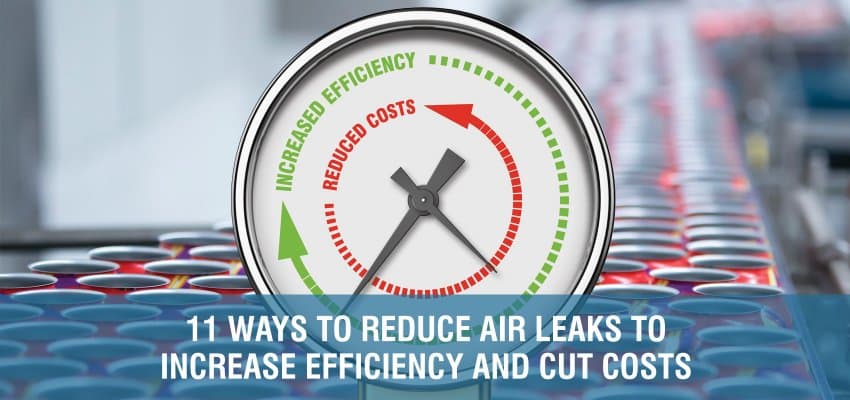10% of electricity supplied to industry is used to compress air, so maximising energy efficiency saves you money.
Estimating potential energy and cost savings in compressed air systems
The first step to reduce compressed air energy costs is to measure and monitor your compressed air system's energy consumption, flow rates and operating air pressure. Small adjustments can reduce your operating pressure and energy costs while improving flow rates and output. Here are 11 steps you can take to optimise your compressed air system and save energy costs.
- Reduction of demand
- Maintenance
- Monitoring
- Reduction of leaks (in pipes and equipment)
- Electronic condensate drain traps (ECDTs)
- Reduction of the inlet air temperature
- Maximising allowable pressure dew point at air intake
- Optimising the compressor to match its load
- Proper pipe sizing
- 1Heat recovery
- Installing variable speed compressors
Energy efficiency support for your compressed air system
If you'd like to improve energy efficiency of your compressed air system, Cambs Compressors can help. Why not arrange your FREE Air Energy Audit now? Contact us today! Reducing waste in compressed air so it's delivered more efficiently can be a few simple steps.
"Most blow guns are simply open-ended pipes: fitting a nozzle can use 30% less compressed air and, by making the operation much quieter, improve the working environment."
Here are 11 steps you can take to optimise your compressed air system and save energy costs.
1. Reduction of demand
Because of the relatively expensive operating costs of compressed air systems, the minimum quantity of compressed air should be used for the shortest possible time, constantly monitored and reweighed against alternatives.
2. Maintenance
Inadequate maintenance can lower compression efficiency, increase air leakage or pressure variability and lead to increased operating temperatures, poor moisture control and excessive contamination. Better maintenance will reduce these problems and save energy.
3. Monitoring
Maintenance can be supported by monitoring using proper instrumentation, including following:
- Pressure gauges on each receiver or main branch line and differential gauges across dryers, filters, etc.
- Temperature gauges across the compressor and its cooling system to detect fouling and blockages.
- Flow meters to measure the quantity of air used.
- Dew point temperature gauges to monitor the effectiveness of air dryers.
- kWh meters and hours run meters on the compressor drive.
4. Reduction of leaks (in pipes and equipment)
Leaks cause an increase in compressor energy and maintenance costs. The most common areas for leaks are:
- Couplings
- Hoses
- Tubes
- Fittings
- Pressure regulators
- Open condensate traps and shut-off valves
- Pipe joints
- Disconnects
- Thread sealants
In addition to increased energy consumption, leaks can make pneumatic systems/equipment less efficient and adversely affect production, shorten the life of equipment, leading to additional maintenance requirements and increased unscheduled downtime. The payback period depends on the amount of leakage reduced, and is determined by the pressure, operating hours, the physical size of the leak and electricity costs.
5. Electronic condensate drain traps (ECDTs)
Due to the necessity to remove condensate from the system, continuous bleeding, achieved by forcing a receiver drain valve to open, often becomes the normal operating practice, but is extremely wasteful and costly in terms of air leakage.
6. Reduction of the inlet air temperature
Reducing the inlet air temperature reduces energy used by the compressor. In many plants, it is possible to reduce this inlet air temperature by taking suction from outside the building. Importing fresh air has paybacks of up to 5 years, depending on the location of the compressor air inlet.
As a rule of thumb, each 3°C reduction will save 1% compressor energy use (CADDET, 1997; Parekh, 2000).
7. Maximising allowable pressure dew point at air intake
Choose the dryer that has the maximum allowable pressure dew point, and best efficiency. A rule of thumb is that desiccant dryers consume 7 to 14% and refrigerated dryers consume 1 to 2% of the total energy of the compressor.
Consider using a dryer with a floating dew point. Note that where pneumatic lines are exposed to freezing conditions, refrigerated dryers are not an option.
8. Optimising the compressor to match its load
Plant personnel have a tendency to purchase larger equipment than needed (that’s true indeed), driven by safety margins or anticipated additional future capacity. Given the fact that compressors consume more energy during part-load operation, this is something that should be avoided.
9. Proper pipe sizing
Pipes must be sized correctly for optimal performance or resized to fit the compressor system. Inadequate pipe sizing can cause pressure losses, increase leaks and increase generating costs. Increasing pipe diameter typically reduces annual compressor energy consumption by 3%.
10. Heat recovery
More than 85% of the electrical energy used by an industrial air compressor is converted into heat. With large water-cooled compressors, recovery efficiencies of 50 to 60% are typical. When used for space heating, the recovered heat amount to 20% of the energy used in compressed air systems annually.
11. Installing variable speed compressors
When there are strong variations in load and/or ambient temperatures there will be large swings in compressor load and efficiency. In those cases installing a variable speed compressor may result in attractive payback periods.
FREE Air Energy Audit
If you'd like to improve energy efficiency of your compressed air system, Cambs Compressors can help. Why not arrange your FREE Air Energy Audit now?



